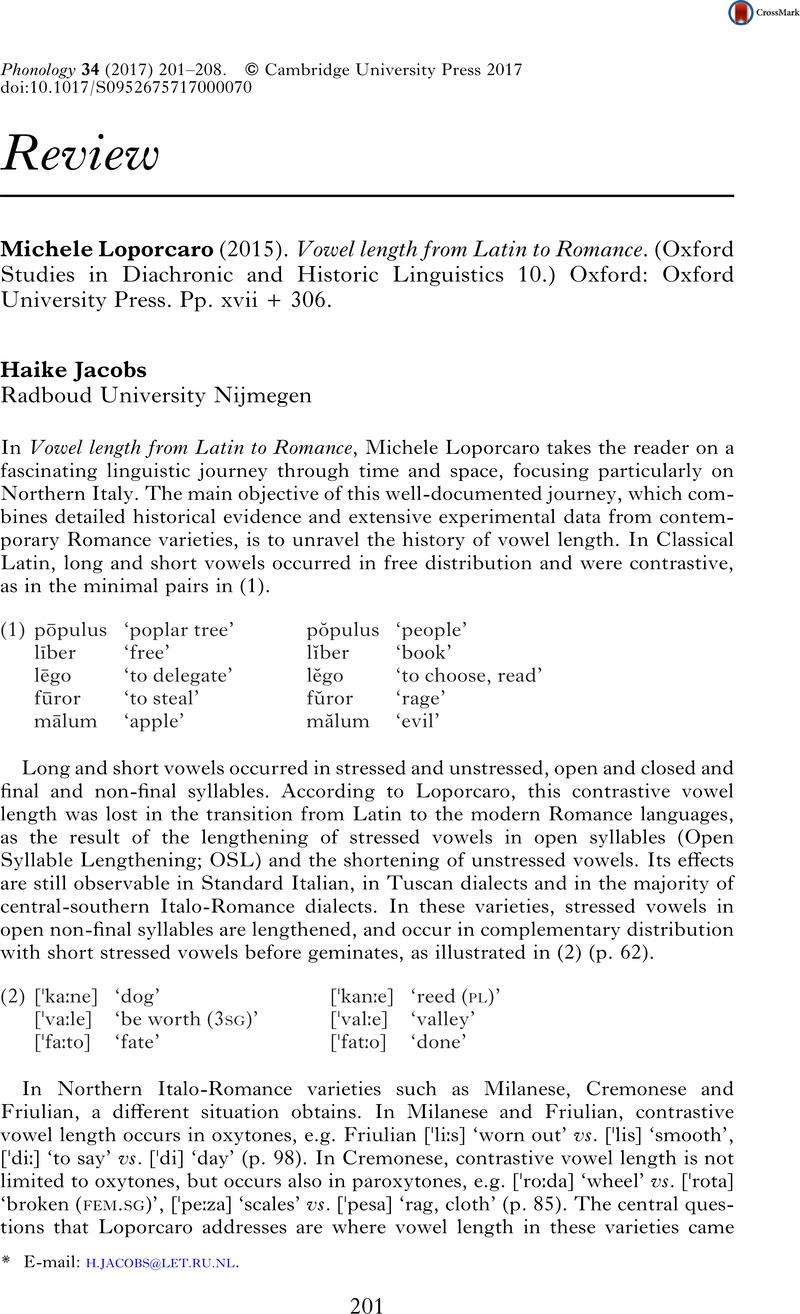No CrossRef data available.
Article contents
Michele Loporcaro (2015). Vowel length from Latin to Romance. (Oxford Studies in Diachronic and Historic Linguistics 10.) Oxford: Oxford University Press. Pp. xvii + 306.
Published online by Cambridge University Press: 05 May 2017
Abstract
An abstract is not available for this content so a preview has been provided. Please use the Get access link above for information on how to access this content.

- Type
- Review
- Information
- Copyright
- Copyright © Cambridge University Press 2017
References
REFERENCES
Baković, Eric (2011). Opacity and ordering. In Goldsmith, John, Riggle, Jason & Yu, Alan (eds.) The handbook of phonological theory. 2nd edn.
Malden, Mass. & Oxford: Wiley-Blackwell. 40–67.Google Scholar
Calabrese, Andrea (1984–85). Metaphony in Salentino. Rivista di grammatica generativa
9–10. 3–140.Google Scholar
Crosswhite, Katherine M. (2001). Vowel reduction in Optimality Theory. New York & London: Routledge.Google Scholar
D'Imperio, Mariapaola & Rosenthall, Sam (1999). Phonetics and phonology of main stress in Italian. Phonology
16. 1–28.CrossRefGoogle Scholar
Fischer-Jørgensen, Eli (1987). Segment duration in Danish words: dependency on higher level phonological units. In Channon, Robert & Shockey, Linda (eds.) In honor of Ilse Lehiste. Dordrecht: Foris. 51–73.Google Scholar
Gussenhoven, Carlos & Jacobs, Haike (forthcoming). Understanding phonology. 4th edn.
London: Routledge.Google Scholar
Hayes, Bruce (1995). Metrical stress theory: principles and case studies. Chicago: University of Chicago Press.Google Scholar
Jacobs, Haike (2003). Why preantepenultimate stress in Latin requires an OT-account. In Fikkert, Paula & Jacobs, Haike (eds.) Development in prosodic systems. Berlin & New York: Mouton de Gruyter. 395–418.Google Scholar
Jacobs, Haike (2008). Sympathy, comparative markedness, OT-CC and Latin syncope. Probus
20. 235–255.Google Scholar
Jacobs, Haike (2009). La lénition romane: l'héritage martinétien et sa modélisation formelle. Recherches linguistiques de Vincennes
38. 83–104.Google Scholar
Kiparsky, Paul (1995). The phonological basis of sound change. In Goldsmith, John A. (ed.) The handbook of phonological theory. Cambridge, Mass. & Oxford: Blackwell. 640–670.Google Scholar
Lahiri, Aditi, Riad, Tomas & Jacobs, Haike (1999). Diachronic prosody. In van der Hulst, Harry (ed.) Word prosodic systems of the languages of Europe. Berlin & New York: Mouton de Gruyter. 335–422.Google Scholar
Lehiste, Ilse (1971). Temporal organization of spoken language. In Hammerich, L. L., Jakobson, Roman & Zwirner, Eberhard (eds.) Form and substance: phonetic and linguistic papers presented to Eli Fischer-Jørgensen. Odense: Akademisk Forlag. 159–169.Google Scholar
Lindblom, Björn & Rapp, Karin (1973). Some temporal regularities of spoken Swedish. Papers from the Institute of Linguistics, University of Stockholm
21.Google Scholar
Lindsay, W. M. (1894). The Latin language: an historical account of Latin sounds, stems, and flexions. Oxford: Clarendon.Google Scholar
McCarthy, John J. (2007). Derivations and levels of representation. In de Lacy, Paul (ed.) The Cambridge handbook of phonology. Cambridge: Cambridge University Press. 99–117.Google Scholar
Montreuil, Jean-Pierre Y. (1991). Length in Milanese. In Wanner, Dieter & Kibbee, Douglas A. (eds.) New analyses in Romance linguistics. Amsterdam & Philadelphia: Benjamins. 37–47.Google Scholar
Morin, Yves Charles (2006). On the phonetics of rhymes in Classical and Pre-classical French: a sociolinguistic perspective. In Gess, Randall S. & Arteaga, Deborah (eds.) Historical Romance linguistics: retrospective and perspectives. Amsterdam & Philadelphia: Benjamins. 131–162.Google Scholar
Prieto, Pilar (1992). Compensatory lengthening by vowel and consonant loss in early Friulian. Catalan Working Papers in Linguistics
2. 205–244.Google Scholar
Prieto, Pilar (1994). Historical vowel lengthening in Romance: the role of sonority and foot structure. In Mazzola, Michael L. (ed.) Issues and theory in Romance linguistics: selected papers from the 23rd linguistic symposium on Romance languages. Washington, DC: Georgetown University Press. 87–107.Google Scholar
Prieto, Pilar (2000). Vowel lengthening in Milanese. In Repetti, Lori (ed.) Phonological theory and the dialects of Italy. Amsterdam & Philadelphia: Benjamins. 255–272.Google Scholar
Prince, Alan (1990). Quantitative consequences of rhythmic organization. CLS
26:2. 355–398.Google Scholar
White, Laurence & Turk, Alice E. (2010). English words on the Procrustean bed: polysyllabic shortening reconsidered. JPh
38. 459–471.Google Scholar




